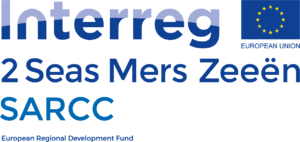PR 00205: verschil tussen versies
Geen bewerkingssamenvatting |
Geen bewerkingssamenvatting |
||
| Regel 9: | Regel 9: | ||
Mean sea level rise (SLR) could increase by 1.5m-2.5m by 2100. This could cause damage by coastal flooding in Europe to increase from €1.25bn per annuum currently to €961bn in just over 80 years (European Commission, 2018). Urban areas situated along the 2 Seas coastline are particularly vulnerable to extreme Sea Level Rise (a combination of SLR, tide and storm surges). Coastal flood plans and policies focus predominantly on deploying traditional grey infrastructure/heavy engineering and ignore the use of NBS, despite the overwhelming evidence of their potential to reduce flood risk and provide multiple benefits. NBS are often not considered by policy-makers in detail due to the perceived risks around costs, potential for success, requirements for immediate protection / improvement and uncertainties regarding future change. A clear knowledge gap exists across coastal local authorities to deploy NBS as a means to reduce future coastal flood risk and economic damage.{{Cite|resource=Resource Hyperlink 00557|name=(SARCC partnership,2019)|dialog=process-linkwebsite-dialog}} | Mean sea level rise (SLR) could increase by 1.5m-2.5m by 2100. This could cause damage by coastal flooding in Europe to increase from €1.25bn per annuum currently to €961bn in just over 80 years (European Commission, 2018). Urban areas situated along the 2 Seas coastline are particularly vulnerable to extreme Sea Level Rise (a combination of SLR, tide and storm surges). Coastal flood plans and policies focus predominantly on deploying traditional grey infrastructure/heavy engineering and ignore the use of NBS, despite the overwhelming evidence of their potential to reduce flood risk and provide multiple benefits. NBS are often not considered by policy-makers in detail due to the perceived risks around costs, potential for success, requirements for immediate protection / improvement and uncertainties regarding future change. A clear knowledge gap exists across coastal local authorities to deploy NBS as a means to reduce future coastal flood risk and economic damage.{{Cite|resource=Resource Hyperlink 00557|name=(SARCC partnership,2019)|dialog=process-linkwebsite-dialog}} | ||
[[Bestand:GJ2MXB.jpg|miniatuur|Image of coast (SARCC partnership, 2019)]] | [[Bestand:GJ2MXB.jpg|miniatuur|Image of coast (SARCC partnership, 2019)]] | ||
{{Project config}} | {{Project config}} | ||
{{Project | {{Project | ||
|Name=SARCC | |||
|Supercontext=Resilient Deltas | |Supercontext=Resilient Deltas | ||
|Start date=2019/12/13 | |Start date=2019/12/13 | ||
|End date=2022/01/31 | |||
|Summary=Het project SARCC gaat over waterveiligheid in gebieden om de Noordzee. | |Summary=Het project SARCC gaat over waterveiligheid in gebieden om de Noordzee. | ||
|Show summary=Nee | |Show summary=Nee | ||
|Show extra=Nee | |||
|Show navigation tree=Ja | |Show navigation tree=Ja | ||
|Show new page button=Ja | |Show new page button=Ja | ||
| Regel 29: | Regel 29: | ||
|Show category label=Ja | |Show category label=Ja | ||
|Show title=Ja | |Show title=Ja | ||
|Project type=Standaard | |||
}} | }} | ||
Versie van 25 aug 2022 10:06
Sustainable and Resilient Coastal Cities (SARCC) is an Interreg 2 Seas program that will mainstream nature-based solutions (NBS) into coastal management and policy making. This could contain stand alone projects or NBS-hybrids, where they are integrated into existing grey infrastructure and flood defenses. The project is about building the capacity of urban leaders, decision-makers and officers involved in coastal flood defenses to deploy NBS and understand the additional benefits that they offer in comparison to traditional grey infrastructure.
The HZ University of Applied Sciences and the Katholieke Hogeschool Vives Noord are responsible, within Work Package 1 (WP1), to develop a monitoring programme that will run throughout the term of the project and will apply across all the SARCC pilot NBS sites. The programme will be iterative with a staged evaluation process that will use the same questionnaires at each pilot site to access the different phases of development. These phases will be the (1) Design Phase: (2) Implementation Phase: (3) Public Engagement Phase: (4) Monitoring Phase: (5) Completion Phase. The evaluation questionnaires (EQs) will be directly comparable to ensure that the outputs are inclusive and holistic. Regular workshops will be held by the WP1 Partners at the NBS Pilot Investment sites to facilitate participation and provide cross border training to complete the EQs.
This web page is an online environment to evaluate and learn from the SARCC pilot projects. For more information about the project, the SARCC webpage is accessible through this link.
Why is this project needed?
Mean sea level rise (SLR) could increase by 1.5m-2.5m by 2100. This could cause damage by coastal flooding in Europe to increase from €1.25bn per annuum currently to €961bn in just over 80 years (European Commission, 2018). Urban areas situated along the 2 Seas coastline are particularly vulnerable to extreme Sea Level Rise (a combination of SLR, tide and storm surges). Coastal flood plans and policies focus predominantly on deploying traditional grey infrastructure/heavy engineering and ignore the use of NBS, despite the overwhelming evidence of their potential to reduce flood risk and provide multiple benefits. NBS are often not considered by policy-makers in detail due to the perceived risks around costs, potential for success, requirements for immediate protection / improvement and uncertainties regarding future change. A clear knowledge gap exists across coastal local authorities to deploy NBS as a means to reduce future coastal flood risk and economic damage.(SARCC partnership,2019)


